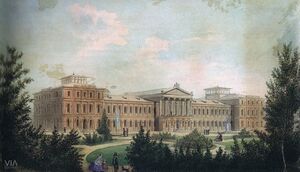University of Bucharest
(University) | |
|---|---|
 | |
| Motto | Virtute et sapientia (Latin: "By virtue and wisdom") |
| Formation | 1864 |
| Headquarters | Bucharest, Romania |
| Type | Public |
| University of national Romanian importance. | |
The University of Bucharest (Template:Lang-ro), commonly known after its abbreviation UB in Romania, is a public university founded in 1864 by a decree of Prince Alexandru Ioan Cuza to convert the former Princely Academy into the current University of Bucharest, making it the second oldest modern university in Romania. It is one of the five members of the Universitaria Consortium (the group of elite Romanian universities).[1]
The University of Bucharest offers study programmes in Romanian and English and is classified as an advanced research and education university by the Ministry of Education. In the 2012 QS World University Rankings, it was included in the top 700 universities of the world, together with three other Romanian universities.[2]
History
The University of Bucharest was founded by the Decree no. 765 of July 4, 1864 by Prince Alexandru Ioan Cuza and is a leading academic centre and a significant point of reference in society.
The University of Bucharest is rich in history and has been actively contributing to the development and modernization of Romanian education, science, and culture since 1694. In 1694 Constantin Brâncoveanu, ruler of Wallachia, had founded the Princely Academy in Bucharest with lectures delivered in Greek. In 1776, Alexander Ypsilantis, ruler of Wallachia, reformed the curriculum of the Princely Academy, where courses of French, Italian, and Latin were now taught. After 1821, the Princely Academy was continued by the Saint Sava College. In 1857, Carol Davila and Nicolae Crețulescu created the National School of Medicine and Pharmacy. In 1859, the Faculty of Law was created.
In 1857, the foundation stone of the University Palace in Bucharest was laid.
On July 4/16 1864, Prince Alexandru Ioan Cuza established the University of Bucharest, bringing together the Faculties of Law, Sciences and Letters as one single body. In 1869, the Faculty of Medicine is created through the transformation of the National School of Medicine and Pharmacy. In the following years, new faculties were created: 1884 – the Faculty of Theology; 1906 – the Institute of Geology; 1913 – the Academic Institute for Electrotechnology; 1921 – the Faculty of Veterinary Medicine; 1923 – the Faculty of Pharmacy, 1924 – the Mina Minovici Institute of Forensic Medicine.
In 1956, student leaders, mainly from this university, planned a peaceful protest against Romania's Communist regime but were forcibly prevented from carrying it out. (See Bucharest student movement of 1956)
For a while (1950s–early 1960s?), it was called the "C. I. Parhon University", after C. I. Parhon.
Most of the building is still intact, however during the bombardments of Bucharest in 1944, the central corpus of the building was heavily damaged and demolished due to Luftwaffe bombs, and was only re-constructed in 1969–1971. Other sections were also completed by 1980.
The area around the old University building (the University Square), adjacent to the C. A. Rosetti, Roman, Kogălniceanu, and Union Squares was the scene of many riots, protests and clashes with the security forces during the Romanian Revolution of 1989. During the months of April–June 1990, the University of Bucharest was the centre of anti-communist protests.
In 1996, Emil Constantinescu, the then rector of the University of Bucharest, was elected President of Romania, after defeating Ion Iliescu in the 1996 Romanian presidential election.
An Alumnus on Wikispooks
| Person | Born | Summary | Description |
|---|---|---|---|
| Adrian Nastase | 22 June 1950 | Spook Politician Blackmailer | Former Romanian prime minister, now a convicted blackmailer and bribe taker. |
